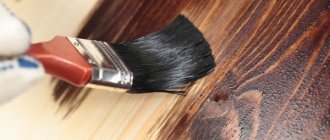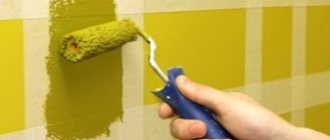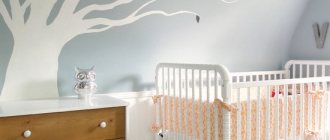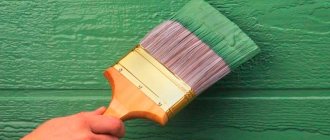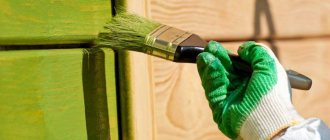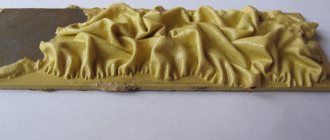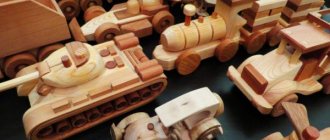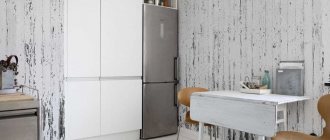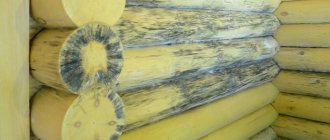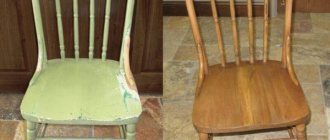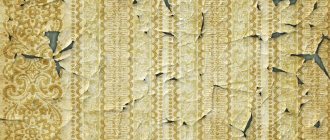Wood is often used to decorate the home. It attracts with its beautiful appearance and large selection of shades. Household items made from this material transform any interior. They stand out among others. But the high cost of finishing work led to the use of other materials. To prevent the beauty and richness of wood from being lost, the technology of painting it to look like wood is used.
Each material is processed according to the scheme. After this, a coating appears on them that imitates the texture of a natural pattern. For this, wood paint is used. Information about what composition is applied and how the steps are performed step by step will help in the work.
Types of paints and their characteristics
Exterior paints are designed to preserve wood and create a surface protective layer.
Mandatory characteristics of trains “working” on the street must meet the following parameters:
- No moisture absorption;
- Frost resistance, i.e. ability to withstand numerous freeze-thaw cycles;
- Availability of a UV filter. Protecting wood from sunlight, which causes the “tanning” effect of natural material, which leads to loss of appearance;
- Antiseptic properties and biological protection;
- Resistance to abrasion and other mechanical influences.
Two-step craquelure
Two-step craquelure
imitates cracks that appear in the varnish over time. I will show how to create these cracks without covering the wood with paint or primer so that the texture of the wood remains visible. But, of course, such cracks can be created over a painted surface, or over decoupage, or painting, or even painting.
First I apply several layers of shellac varnish. I took the unbleached one because I really liked it in one of the previous methods. Wood is a very absorbent material, so you don’t even need to take into account the first layer of varnish; it will be completely absorbed. After it, it is better to apply another 3-4 layers of shellac varnish with intermediate drying.
Then, as in one-step craquelure, I distribute a thick layer of craquelure varnish over the surface. I leave it to dry for a day. In the morning, these gorgeous cracks appear in the light. If your room is humid or cool, there may be fewer cracks, then you need to warm the surface with warm air from a hairdryer. Craquelure loves dryness and warmth. To show the cracks, I rub oil paint into them. I cover the craquelure with shellac varnish.
Types of wood paints for facade work
Water-based acrylic paints
The water emulsion contains acrylic binders that form a thin film on the surface of the wood after the water evaporates.
The film is elastic, does not collapse due to seasonal changes in wood, is vapor permeable (“breathable”), and has high waterproofing properties.
The composition does not have a strong odor, is highly resistant to temperature changes and adverse atmospheric conditions. It is used for painting wooden facades of houses, lining, timber, blockhouse and imitation timber.
Water-based latex paints
Latex paints are resistant to wet abrasion, do not fade in direct sunlight and are characterized by the elasticity of the layer. The paint also contains acrylic resins, which expands the list of performance characteristics of the composition.
Additives of synthetic latex improve the visual effect and give the surface a silky appearance.
Suitable for use on the facades of wooden houses, painting window frames, doors, wooden fences.
Alkyd compositions
The composition contains alkyd resins, which, when dry, form a glossy texture with increased resistance to temperature and humidity changes. They do not penetrate deep into the wood and fade quickly.
Used for painting frames and doors, wooden surfaces that are not subject to strong mechanical stress.
Oil paints
They are a covering composition, which affects their low consumer characteristics. Paints wear out quickly, lose color, and are unstable at low temperatures.
Used for painting fences and railings.
As a rule, all manufacturers declare the presence of the listed properties in their formulations. But in reality, there is a rapid loss of performance under real operating conditions.
In this article we will highlight the most interesting compositions from leading manufacturers and consider in detail the properties of each paint.
All presented paints from leading manufacturers have been tested in practice and have earned truly high marks. The properties were tested in the middle zone climate with frequent temperature changes in winter (frost-thaw), with intense solar load and rain typical for this area.
Brushing without firing + washing technique
Of course, you can brush wood without firing it, which is exactly what I did before I bought the burner.
This can be done with special drill attachments and hard metal brushes. Or brush by hand, which is what I do. This, of course, is a great way to keep warm when there is no heating) You definitely need to sand the board after brushing so as not to get splinters.
Next I start painting. I apply purple and immediately wash off the unabsorbed paint with a wet rag. I introduce an additional color in some places - ultramarine - and do the same with it.
This technique allows you to delicately highlight the texture of the board. Next, I take green Chameleon paint, apply it to the entire surface, and also wash away the residue, allowing it to remain only in the depths of the pores. After drying, a delicate pearlescent effect is obtained.
What to look for when choosing paint
When choosing the appropriate composition, you should pay attention to several factors.
- Type of wood. Different breeds have their own characteristics, which affect the quality of coloring.
- Terms of Use. Surfaces indoors and outdoors are exposed to varying degrees of impact. When purchasing paints and varnishes, it is recommended to take into account: humidity, the presence of sunlight, exposure to smoke, temperature changes, mechanical stress and some other nuances.
- Preliminary surface treatment. For the most effective protection of wood and long service life, the surface must be primed before painting. This will enhance the protective properties and ensure the leveling of the absorbent base.
- Previously applied compounds. The primer must be compatible with the paint. Otherwise, it is better to completely remove the previously applied layer.
For woodworking, glazes and antiseptics, varnishes, water-based impregnations and stains, as well as covering paints and enamels are used. Let's look at each type in more detail.
- Glazing coatings (impregnations, glazes, varnishes). The texture of the wood is clearly visible through the applied layer. Such materials help preserve the natural appearance of the wooden surface and give a decorative effect, emphasizing the advantages of the surface.
- Covering compositions (oil, alkyd, acrylic paints). These materials are made on different bases, both organic and water-based. Alkyd and oil paints are more traditional and affordable, but less durable.
Acrylic paints are famous for their durability and wear resistance. Their advantages also include quick drying and lack of odor.
- Opaque enamels (alkyd, acrylic, polyurethane). These compositions are also produced with the participation of polymers. After drying, they form a hard layer resembling a “crust”, which provides them with resistance to external factors.
The most affordable is alkyd enamel.
It reliably protects the wooden surface from moisture, however, such compounds are the most toxic. Polyurethane paints are characterized by good elasticity, due to which they are resistant to mechanical stress and last longer than others.
Let's get ready
Tools and materials
Very often, furniture that was produced in the USSR is of such high quality that it can last for many years, which cannot be said about many modern models. In addition, vintage-style home furnishings are now more popular than ever before. For this reason, painting furniture to look like wood would be an ideal solution.
But how to do everything without noise and dust, and at the same time not turn your favorite apartment into the abode of an incompetent painter, which can smell of all kinds of toxic products? To do this, you will need to purchase special tools and materials.
For painting you will need the following:
- Paint for painting wooden furniture.
- Gloves.
- Paint tray.
- Furniture that is subject to restoration.
- Masking tape.
- Brushes or roller.
Before you begin, you should prepare the furniture. For this you will need:
- Protective glasses.
- Gloves.
- Rubber spatula.
- Paint tray.
- Brushes or roller.
- Glasses for protection.
- Fine grit sandpaper.
- Wooden block or sanding machine.
When you have prepared all the tools and materials, you can begin. But before painting, it is worth bringing the furniture into proper condition so as not to make mistakes when painting.
Preparing furniture for painting
Proper preparation is the key to success. For this reason, you should carefully read the instructions and do everything exactly as described so that after painting you get the desired effect.
- First, inspect the furniture you want to restore for minor damage. If necessary, you can repair or replace some of the mechanisms, such as hinges, handles and locks. If the varnish on the furniture begins to peel, it should also be removed. Then remove all the doors, remove the drawers and unscrew the locks and handles.
- When everything is disassembled, you can begin sanding all surfaces (including glossy and matte) with sandpaper. It is the finely coated sandpaper that will not leave scratches that will be difficult to prime or paint over. For convenience, you can use a grinding machine.
- Next, we coat the furniture with a primer, first the surfaces, and then you can seal the problem areas with putty. This will give good grip. The surface can be degreased with alcohol or vodka - they will not leave a slippery film on the furniture.
- In order for painting wood furniture to be successful, you should not neglect the next step. You need to apply an acrylic primer and thoroughly saturate all minor damage such as scratches and cracks. To do this, use a brush. Next, wait for it to dry completely.
- Arm yourself with a rubber spatula and putty to hide any remaining defects.
- After drying, sand the areas where the primer and putty were applied. To do this, you can use sandpaper or a sanding machine. Depending on the depth of the defects and the layer of material, this operation may have to be repeated several times.
- At the end of the work, prime everything and get rid of dust.
Advice! When choosing a primer, try to choose a shade that will closely match the shade of the furniture. This will not only make the color even, but also make it possible to save on paint.
Which paint to choose
The paint for painting wooden furniture must be chosen correctly. To do this, you should pay attention to the material of manufacture. There are many varnishes that will help not only give the desired shade to surfaces, but also protect against parasites, moisture and dirt.
Article on the topic: Where to get furniture for a design project
The following types of varnishes are usually used:
- Epoxy.
- Oily.
- Alcohol.
- Alkyd.
- Polyurethane.
- Nitrocellulose.
Unlike paint, varnish adds durability and hardness to the surface. But if you have not yet decided on what paint to paint your furniture, make a choice in favor of any paint from the list below:
- Acrylic paints are traditional among furniture finishing products. They dry quickly, are durable, convenient to use and are great for treating furniture that will be placed in the kitchen and children's room. In addition, acrylic paints do not have a strong odor and are easy to dilute with water, which makes it possible to save money.
- Acrylic paints in cans will make the work easier and simplify the process. This paint applies smoothly to the surface and dries faster than those applied with a brush or roller.
- Lacquer enamel paints, when applied to wood, add gloss and shine. If you want to achieve a matte finish, oil-based paints will help you.
- To preserve the structure of a wooden surface, use transparent paints. The range of these is large, and the consistency makes it possible to mix a variety of shades to get what you need.
Stages of painting (using the example of a kitchen cabinet)
Most likely, you are thinking about one or another piece of furniture that can be painted. Very often these are kitchen cabinets, since they suffer from mechanical stress and moisture more than other furniture. Let's use a kitchen cabinet as an example to paint wooden furniture with our own hands.
Please note that when buying unfinished kitchen cabinets, 8 out of 10 times you will find birch. This wood has a fine-grained structure, and stain will look great on it. For example, when using a stain with a cherry tint, you can easily achieve a cherry color.
Stage No. 1: sanding the wood. This is the most important stage in preparation. Use 120 grit sandpaper and you can easily sand the wood. It is important to do this in the direction of the texture to avoid scratching. Next, take 220-grit sandpaper and sand the surface again to remove scratches and create a smooth surface.
Article on the topic: Why furniture is expensive
Stage No. 2: impregnation of wood. To apply impregnation, you should thoroughly wipe the dust from the surface. In this case, the impregnation will serve as a sealant and promote uniformity during painting. After application, you need to wait until it dries completely.
Stage No. 3: applying stain. Ideally, it should be applied with a brush and in circular motions so that the product is well rubbed into the wood texture. Apply the final coat in the direction of the texture to obtain a perfectly smooth surface.
Stage No. 4: coloring. Paint, as such, will not protect the surface from moisture, drying and parasites. For this reason, you should study the composition of the paint in advance, since you will probably have to purchase additional additives for the protective layer.
Requirements for paints for exterior use
When choosing paint for exterior use, you should pay attention to how resistant it is to a number of factors:
- humidity;
- sun rays;
- high and low temperatures;
- detergents and chemicals;
- rotting;
- fungal development;
- reproduction of pests.
Such compositions are allowed to be used in the temperature range from -40 to +50 degrees. It is desirable that they lay easily and evenly on the surface and have protective and decorative properties.
Paints for exterior use must be wear-resistant, vapor-permeable and durable.
To paint outdoor objects, you can safely use water-based façade materials and acrylic enamels. If you have to save your budget, then alkyd enamels are a good option, but you need to take into account that such a coating will last a much shorter period of time.
CLEANING
The very first thing you need to do before cleaning any piece of furniture is to give it a thorough cleaning. No matter what type of paint you use, it will not stick to grease, dust or other dirt. Another option is to just use warm water and dish soap because it's cheap, easy to have on hand, and amazing at removing grease and dust.
Requirements for paints for interior work
Interior paints must meet the following criteria:
- health safety;
- high drying speed;
- no pungent odor.
Wear resistance for such materials is not so important. Exceptions include floor, bathroom or kitchen paints. Acrylic and polyurethane water-dispersed compositions are ideal for treating indoor surfaces.
However, they are relatively expensive, which limits their growth in popularity.
Thus, the choice of paint and varnish materials is influenced by many factors: from the financial capabilities of the buyer to the operating conditions of the painted products. If you encounter any difficulties, you can always turn to salespeople at retail outlets for help.
Preparation of materials and tools
Regardless of how your handmade masterpiece turns out, you will need some materials and tools. To paint wooden furniture you may need:
- LMB. Paint can be purchased in cans or spray cans;
- varnish or stain. Protective coating, matte or glossy, your choice;
- primer and putty are necessary to prepare wood for painting;
- plastic film or newspaper will be useful for covering glass, non-removable fittings and other structural elements;
- sandpaper. It is better to stock up on several types with different grain sizes, which will be needed to remove the old coating and eliminate base defects;
- auxiliary materials, such as a spatula, a container for diluting paint, a solvent;
- brushes (narrow and wide), rubber roller;
- respirator, rubber gloves, safety glasses.
Having prepared everything you need, you can move on. And the first step in painting furniture at home is choosing the right paint.
Painting methods
There are several painting methods: using a special grater, mixing liquid paints, applying soot. The choice is made taking into account the type of surface.
Using a rubber float
This option is considered the simplest; most beginners choose it.
First, a layer of light enamel is applied, which is then left until completely dry. Then a dark dye is applied. There is no need to wait until it dries: it should only dry out a little.
Then they take a grater made of rubber with a carved pattern that imitates a pattern on natural wood. Using a tool, marks are left on the surface.
At the same time, light dye will appear through the dark dye, which will create the effect of natural wood.
When the master finishes the decoration work, you should leave the product to dry completely. Only after this can you start applying varnish. It is recommended to apply it in 2-3 layers. When the varnish is completely dry, the item can be placed in its original place and used.
Before working with furniture or doors, it is recommended to try using a grater on unnecessary surfaces.
Liquid mixing
This complex technique requires artistic taste and work experience. Suitable for working with large objects with a flat surface; Small, curved things will be difficult to repaint. With its help you can get original color solutions.
First, light enamel is applied; You can use any tool for this. It will have to dry a little; You should not overdry, the surface should remain slightly damp. Then you will need a brush.
With its help, a dark dye is applied on top of the liquid bottom layer. Since the shades will mix during work, streaks will remain on the surface.
Outwardly, they will look like a cut of wood. When the work is completed, the paint is left to dry. After the dye has completely hardened, the base is coated with varnish.
Applying soot
This painting technique is considered simple; it is used for plastic objects (for example, in the interior of a car). Can also be used for other materials: wood, metal. You need to use enamel of only one shade (it is better to take dark ones; on light ones the soot will stand out sharply).
In addition, you will need to take a plastic stick (a cocktail straw, fork, spoon or knife from a set of disposable cutlery will do).
First, the product is completely covered with dark dye, after which it must dry completely. The stick is then set on fire. When it starts to smoke, apply a design with the end, bringing it to the surface. Uneven dark spots of soot will help you get an original pattern.
When the work is completed, the result should be secured with 2 layers of varnish.
Putty damage
Before applying putty, you must carefully inspect the furniture, disassembling it into as many parts as possible. After this, it will be possible to process all places and replace failed or outdated fittings.
First, sanding is carried out, dust is removed with a dry cloth, then treated with an antiseptic to prevent the development of fungus. And only after that the detected defects are repaired with transparent putty. The product is applied in a thin layer and carefully leveled. Wait until the putty dries and, if necessary, apply another layer. The final stage is sanding the putty areas.
Features of wood design
In order for the treated surface of the material to have maximum resemblance to natural wood, you need to correctly select shades of paint. Using paint, it is possible to make artificial fakes to decorate the interior design of a room. Wood-look paint for doors is sold in a wide range in hardware stores.
Painting doors to look like wood requires the following steps:
- 1. The room is freed as much as possible from furniture and other unnecessary objects and parts.
- 2. The surface is being cleaned for painting.
- 3. Using a brush, a layer of base paint is applied to the surface of the door.
- 4. When the base paint has dried, the surface is cleaned with fine-grained sandpaper.
- 5. Next, painting is done with paint of a darker shade.
- 6. Without waiting for it to dry, a design is applied to the surface using a comb, thus creating an imitation of wood.
- 7. When the paint has dried, it is sanded and varnished.
Creating a Texture
1. Dip the tip of a fan-shaped brush into the black glaze. Remove excess frosting with a paper towel.
2. Press the brush against a damp sponge so that the bristles of the brush spread apart. Now brush the brush very lightly over the previously painted surface of the furniture. You should end up with thin lines that imitate wood grain.
3. To make these lines look like real mahogany, draw the fan brush in a straight line, but at a slight angle to the sides of the furniture.
4. Immediately after applying each group of “fibers”, lightly brush over them with a very soft blending brush. This will soften the harsh lines slightly and give them a natural look. Continue this way until all surfaces of the furniture are covered with wood grains.
5. Leave the furniture to dry completely.
Painting plastic to look like wood
There is nothing difficult in carrying out this task. But in order not to spoil the material and make the coating durable, you need to know some quality characteristics of the materials:
- There are types of plastic that cannot be painted;
- after sanding, the plastic is coated with a primer;
- Some types of paints that serve as a solvent for plastic cannot be used for painting.
To achieve a perfect resemblance to wood, you should not use a roller during the painting process. It is best to use a wide, medium-hard brush.
As a result of this painting, the white color of the doors becomes the color of wood. In the interior of the room, a wooden door looks much richer and more prestigious. While maintaining the quality of plastic, the external design of the doors takes on the appearance of a wooden product.
A thin film is applied to the plastic, which imitates the pattern of wood materials.
This gives the door a qualitatively new design solution, while the structure of the material remains the same. When the paint dries, it forms a durable protective layer, similar in appearance to natural wood. A good result is obtained after painting with acrylic paints and varnishes.
Where to begin
Breathing new life into an old shelf, bedside table or chest of drawers is not difficult if you choose the right restoration technique. The choice of decorative material and the technique of its application depend on the creative concept. First you need to determine what the furniture is made of. Any material can be repainted: metal, wood, plastic, etc. It is clear that the composition must correspond to the base.
You don't have to limit yourself to just paint. There are additional design techniques. This includes painting, manually or using stencils, decoupage with drawings or photographs, craquelure application, patination and aging, and much more. The decor is chosen in accordance with the interior style. If you wish, you can find very interesting solutions.
How to paint metal
Imitation of wood can be done even on metal products, including doors made of this material. The technology for preparing metal products is no different from preparing for painting doors made of other materials.
The metal surface is pre-coated with a high-adhesive primer.
Preparation for painting includes the preliminary selection of fire retardant paint for metal. When painting products that will be used outdoors, use paint that will reliably protect against corrosion and is electrically protective.
As for color solutions, the street door is painted to match the color of the facade.
It is best to use powder paint to paint metal to look like wood. It is used in many industrial sectors and in everyday life.
This technology allows you to create an attractive design look for the treated surfaces of products.
Powder paint is applied to the surface using a special sprayer in the preparation chamber. The decoration process is carried out in a thermal chamber at high temperature.
This finish colors doors and other surfaces in Kale and Cremona oak, cherry, Calvados, pine, walnut and beech. A painted door is difficult to distinguish from a product made of natural wood. Any metal coating can be imitated as oak, acacia, walnut and other options.
As a result of the work carried out, the product retains all the advantages of metal and takes on the appearance of natural wood.
Decorating metal products to imitate wood is carried out during the interior design process. Painting technology involves several stages, including proper preparation.
The preparatory process includes:
- degreasing the surface and removing contaminants;
- treatment of the product against corrosion;
- actually, the painting process itself.
After the surface is degreased, a layer of matte paint is applied to it. You need to apply it with a brush, moving along the texture. After the paint has completely dried, a second layer is applied. The result is products that perfectly imitate wood.
The paint is applied in short, scratchy strokes, giving the piece the right texture.
Painting furniture at home
You have brought to life the interior you have dreamed of for so long. However, it can become boring after a few years. You look at the same wallpaper and furniture, but thoughts about a change of scenery creep into your head. The interior requires changes, but the wallet does not tolerate significant expenses. How to be? You can’t really touch the walls, but you can always refresh the look of the furniture. It is the basis in the house and forms its own unique style. It is not necessary to radically change anything. Just choose the color you like and the desired method of applying paint. It's not as difficult as it seems at first glance. Painting it yourself will not be a problem, you just need to understand some issues. In this article, we will look at the important aspects that you need to know before starting work. Let's get started.
The case when grandiose changes are not needed. Leave the decor alone, do not move the sofa from corner to corner. Furniture restoration is the best solution. It’s not that expensive, and you can do it on your own, neglecting the help of professionals. Let's list other advantages:
- If you paint it yourself, you won’t have to spend a lot of time shopping around trying to find a design. Unlike ready-made furniture, you can be creative and give the piece the look you want.
- “Second wind” for antiquity. You shouldn’t throw an outdated chair into the trash, because this has long been an excellent field of work for a modern designer.
- Using a brush and paint you can extend the life of the wood. Restoration will be able to increase the service life of the same cabinets and sets, in turn, this will help save your money.
- Large selection of paints and varnishes. We will return to this point later.
Article on the topic: How to weave furniture from newspaper tubes
It is too early to consider the issue of choosing a brush and basic materials. Let's talk a little about the surface. It varies, so there is no universal approach. Take this into account.
Conclusion: first, it is important to choose the right paint and method of applying it.
Wood texture
Helmet Spray Technology
The surface to be painted is conventionally divided into zones A, B, C, where sector A is considered the most important area. They start painting it last, when the master gets used to working with a spray tool.
The spray gun trigger is pressed exclusively at the edge of the zone, moving in the direction of the wood grain
It is very important to maintain the same distance between the sprayer and the surface, avoid tilting the tool and move it at the same speed. The trigger is released only when the torch approaches the edge of the area to be painted.
The work is inspected in bright light; if defects are found, they are painted over at a faster rate.
Why paint a wooden fence
Before treating wooden fence posts, you need to figure out why you need to paint them at all? The fact is that a fence made of natural material is subject to all sorts of negative influences from the environment.
It is important to know that no matter what kind of durable wood is used to construct the fence, without proper treatment it will not last long - up to a maximum of 7 years. An unpainted structure will lose its original properties much faster, since it will be more sensitive to:
An unpainted structure will lose its original properties much faster, since it will be more sensitive to:
- air humidity and precipitation, which can cause swelling and rotting of the material;
- attacks by bark beetles, which will undermine the wood from the inside and make it fragile and unattractive in appearance;
- the spread of mold or moss on the surface, due to which boards and fence posts will quickly become unusable.
All of the above reasons are a good reason to paint the fence in a timely manner and protect it from adverse natural factors.
Why do this at all?
- Wood is, first of all, a living material and, like any living organism, it lives, ages and dies. If you do not care for it and do not treat it in time, then these processes will go much faster, especially for wood that is in the open air and experiences the whole range of negative weather surprises.
- In addition, this living material is fertile ground for the development of various types of mold and mildew; whole hordes of pests enjoy it.
- Based on the colossal experience of human use of wood, modern science has developed many different compositions that not only improve the appearance of the material, but also make it possible to extend the decent life of wood for decades. Moreover, for each type of wood and type of its use they are different.
